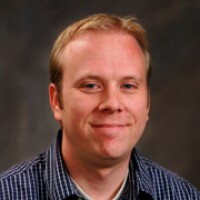On March 22, Jamie Jensen and Seth Bybee, professors in the Brigham Young University Department of Biology, presented at the Inspiring Teaching Series: Gospel Methodology in the Classroom sponsored by General Education. During their presentation, the fourth and final lecture in the series for the winter 2023 semester, Jensen and Bybee discussed how faculty can approach important topics that some students may feel threatened by. As an example, they used the concept of evolution, which can be difficult for students to reconcile with the biblical description of the creation of the world. Jensen and Bybee cited the Gospel Topics Essay on “Organic Evolution” published by The Church of Jesus Christ of Latter-Day Saints, which explains the Church has no official position on the theory of evolution.


During the teaching workshop, Jensen and Bybee demonstrated to faculty that despite perceived conflicts, faith and scientific knowledge are compatible. They shared a quote from President Russell M. Nelson, who said, “There is no conflict between science and religion. Conflict only arises from an incomplete knowledge of either science or religion, or both … ” To demonstrate this idea, Jensen and Bybee presented information about four areas where students may perceive conflicts between scientific knowledge and religion—discussing scriptural, doctrinal, philosophical, and cultural conflict. They gave reasons for the perceived conflict and offered solutions faculty can use to help their students become more comfortable with learning about evolution and other scientific topics.
Jensen and Bybee first discussed scriptural conflict. Students can perceive scriptural conflict when they believe a book of scripture, such as the Bible, must be taken literally or when a passage of scripture is interpreted differently by different Church leaders. Jensen and Bybee suggested faculty can explain multiple possible scriptural interpretations. They counseled against the concept of a “God of the gaps,” meaning the belief that God is only responsible for the phenomena science cannot explain. They argued a scientific process with a logical explanation can still be an intentional result of God’s power.
During the workshop, Jensen and Bybee also addressed perceived doctrinal conflict. This conflict can arise because of a discrepancy in different religious leaders’ interpretations of doctrine, a lack of awareness of doctrine, or a misunderstanding of how doctrine is established. The proposed solution is that faculty provide information about doctrine and clarify how it is established––reminding their students that the First Presidency and the Quorum of the Twelve Apostles establish doctrine, and not every statement made by a Church leader constitutes doctrine binding for the entire Church. Faculty can also help their students be comfortable with a level of uncertainty, as scientific research is always progressing and there are many questions science cannot yet answer.
Another perceived conflict students may see is philosophical in nature. Jensen and Bybee explained that students may see accepting controversial scientific information, such as the theory of evolution, as a “slippery slope” that may have hazardous consequences for them down the road. Students may feel accepting the information could make it more difficult for them to have faith. However, faculty were encouraged to help students understand the nature of science as agnostic pursuit—a pursuit that doesn’t prove or disprove the existence of God. To help students build faith and promote their learning, faculty were encouraged to use language that facilitates cognitive consistency, reassure students it is okay to have questions, allow students to share their points of cognitive conflict, and never belittle students for having questions.
Finally, Jensen and Bybee discussed cultural conflict, which can be perceived by students if they experience identity-protective cognition, have a false impression of community consensus regarding a concept, or when cultural border crossing seems hazardous. Faculty were encouraged to be aware of and sensitive to the different cultures represented in their classroom. Faculty members’ sensitive engagement with differing points of view in the classroom models for students how they should react to views that challenge them. In instances where students don’t feel it is culturally acceptable to accept scientific information, faculty can offer “faith-friendly” resources to facilitate smooth cultural border crossing. Another proposed solution was to provide “in-group” role models. When students see the example of a professor who understands the science well and is also able to find compatibility between the science and their faith, it is easier for students to do the same.
To learn more about helping students overcome perceived conflicts and find cognitive harmony between their faith in Jesus Christ and their knowledge of scientific topics, such as evolution, review the presentation below.

